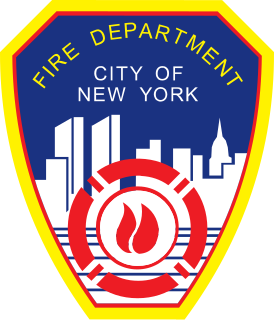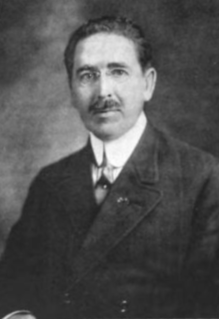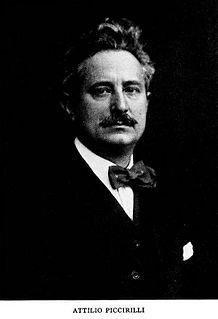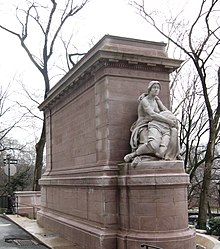
The first memorials to the victims of the September 11 attacks in 2001 began to take shape online, as hundreds of webmasters posted their own thoughts, links to the Red Cross and other rescue agencies, photos, and eyewitness accounts. Numerous online September 11 memorials began appearing a few hours after the attacks, although many of these memorials were only temporary. Around the world, U.S. embassies and consulates became makeshift memorials as people came out to pay their respects.

Riverside Park is a scenic waterfront public park in the Upper West Side, Morningside Heights, and Hamilton Heights neighborhoods of the borough of Manhattan in New York City. The park measures 4-mile (6.4 km) long and 100 to 500 feet wide, running between the Hudson River/Henry Hudson Parkway and the serpentine Riverside Drive.

The New York City Fire Department, officially the Fire Department of the City of New York (FDNY), is an American department of the government of New York City that provides fire protection, technical rescue services, primary response to biological, chemical, and radioactive hazards, and emergency medical services responses to the five boroughs of New York City.

Karl Theodore Francis Bitter was an Austrian-born American sculptor best known for his architectural sculpture, memorials and residential work.

William Ordway Partridge was an American sculptor, teacher and author. Among his best-known works are the Shakespeare Monument in Chicago, the equestrian statue of General Grant in Brooklyn, the Pietà at St. Patrick's Cathedral in Manhattan, and the Pocahontas statue in Jamestown, Virginia.

The New York City Fire Museum is a museum dedicated to the New York City Fire Department (FDNY) in the Hudson Square neighborhood of Manhattan, New York City. It is housed in the former quarters of the FDNY's Engine Company No. 30, a renovated 1904 fire house at 278 Spring Street between Varick and Hudson Streets.

John Quincy Adams Ward was an American sculptor, whose most familiar work is his larger than life-size standing statue of George Washington on the steps of Federal Hall National Memorial in New York City.
The Firefighters Association of the State of New York, more commonly known as FASNY, is an organization whose mission is to educate, serve and support volunteer firefighters in New York State. FASNY was founded in 1872 and its main headquarters are in Albany, New York. Originally known as the Firemen’s Association of the State of New York, it changed its name in 2022. FASNY currently has more than 40,000 members. The Firefighters's Association also maintains the FASNY Firemen's Home and the adjacent FASNY Museum of Firefighting in Hudson NY. FASNY provides information, education and training for the volunteer fire and emergency medical services throughout New York State. FASNY strives to recognize the true champions of these services through numerous awards programs. They also recognize educators for their work in fire prevention education. Additionally, FASNY provides legislative representation that monitors and takes action on topics of importance to the services.

The Soldiers' and Sailors' Memorial Monument is a monument located at 89th Street and Riverside Drive in Riverside Park in the Upper West Side of Manhattan, New York City. It commemorates Union Army soldiers and sailors who served in the American Civil War. It is an enlarged version of the Choragic Monument of Lysicrates in Athens, and was designed by the firm of Stoughton & Stoughton with Paul E. M. DuBoy. The monument was completed in 1902.
The Piccirilli brothers were an Italian family of renowned marble carvers and sculptors who carved many of the most significant marble sculptures in the United States, including Daniel Chester French’s colossal Abraham Lincoln (1920) in the Lincoln Memorial, Washington, D.C.

Harold Van Buren Magonigle (1867–1935) was an American architect, artist, and author best known for his memorials. He achieved his greatest success as a designer of monuments, but his artistic practices included sculpture, painting, writing, and graphic design.

Attilio Piccirilli was an American sculptor. Born in Massa, Italy, he was educated at the Accademia di San Luca of Rome.

The New York State Fallen Firefighters Memorial in Albany, New York is dedicated to the New York firefighters who have died in the line of duty. Governor of New York George Pataki officially dedicated the memorial on October 5, 1998. It features a 54-foot (16 m) by 15-foot (4.6 m) gray granite wall, with 2,312 names permanently etched into the stone. In front of the wall stands a 10-foot (3.0 m) high dark bronze sculpture of two firefighters rescuing an injured colleague created by New York sculptor Robert Eccleston. The sculpture rests on a paved plaza with charcoal and red bricks forming a Maltese Cross. The Memorial stands on the northeast side of the Empire State Plaza in the park-like area bordered by Norway maples. It is easily accessible to the hundreds of thousand of visitors who travel to the New York State Capitol and Plaza each year.

The Kansas City Fire Department provides fire protection and emergency medical service for Kansas City, Missouri, and under contract to Village of the Oaks, Village of Oakwood Park, and Village of Oakwood. It provides fire protection only under contract to City of Lake Waukomis, City of Platte Woods, and City of Weatherby Lake. In addition, it provides EMS support under contract for the City of Riverside. It operates 35 fire stations, one dedicated EMS operations facility housing dynamically deployed ambulances, organized into seven battalions and cover 318 square miles (820 km2).

The Firemen's Monument is a 28 ft 0 in (8.53 m) tall monument in Hoboken, Hudson County, New Jersey, United States, that was designed by American sculptor Caspar Buberl and completed in 1891. The monument was built to commemorate the Volunteer Fire Department in Church Square Park on May 30, 1891.

The USS Maine National Monument is an outdoor monument located at the Merchants' Gate entrance to Central Park, at Columbus Circle, in Manhattan, New York City. It was cast on September 1, 1912 and dedicated on May 30, 1913 to the men killed aboard USS Maine (ACR-1) when the ship exploded in Havana harbor.

The Great New York City Fire of 1845 broke out on July 19, 1845, in Lower Manhattan, New York City. The fire started in a whale oil and candle manufacturing establishment and quickly spread to other wooden structures. It reached a warehouse on Broad Street where combustible saltpeter was stored and caused a massive explosion that spread the fire even farther.
The Vulcan Society, founded in 1940, is a fraternal organization of black firefighters in New York City, United States.
The American Memorial to Six Million Jews of Europe, also referred to as the Warsaw Ghetto Memorial, is a public Holocaust memorial situated at Warsaw Ghetto Memorial Plaza in Riverside Park, within the Upper West Side of Manhattan, New York City. It is a monument to the Warsaw Ghetto Uprising and the six million Jews who were murdered in the Holocaust. Dedicated on October 19, 1947, it is one of the first memorials to the Holocaust in the United States.

















